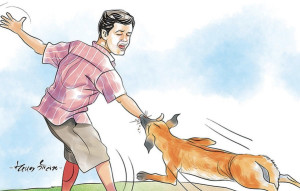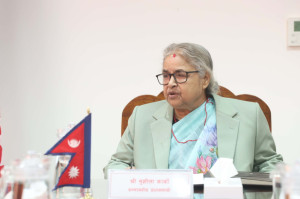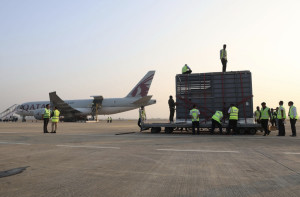Mon, Jan 5, 2026
Columns
Climate threats to agriculture
Farming practices in Nepal lack progress, with continued low crop yields and heavy reliance on seasonal rainfalls.
bookmark
Bishow Parajuli
Published at : August 6, 2025
Updated at : August 7, 2025 07:10
The farming sector is facing a high risk of crop failures and uncertainties in farm productivity due to the decline in rainfall. Other climate variables, such as high wind speeds, as well as insect infestation and diseases, attributed to climate change, are also creating problems. These uncertainties are expected to worsen with unpredictable weather conditions affecting agriculture, and will, in turn, need comprehensive adaptation measures.
Consecutive years of droughts and crop failures in Eastern and Southern Africa and other countries have been causing humanitarian crises. Governments are increasing efforts by prioritising adaptation and resilience-building measures, as part of national priorities to improve and sustain agriculture and improve food security.
Numerous improvements have occurred globally in farming practices over the years; yet, farming practices in Nepal lack improvements, with continued low crop productivity and heavy reliance on seasonal rainfalls.
With most farmers following traditional farming practices with low yields, they face shortages in fertilisers and other farm inputs, which will ultimately increase the cost of production—and continue to face low prices for their produce and have difficulties in accessing markets. Several irrigation projects are pending, and basic support to farmers, commonly available in many other countries to increase productivity is missing in Nepal. There must be different emphasis and efforts to grow various crops, fruits, vegetables and medicinal plants based on climate zones and other adaptation measures.
The movement of close to 800,000 youth out of the country yearly for employment and increased mobility to urban areas has left farmland unattended and fallow. In many districts, farming responsibilities have fallen on women, who have become the only labour force available in agriculture in many rural areas.
Several districts in Terai—Sarlahi, Mahotari, Siraha, Dhanusha and Saptari—are currently facing significantly lower rainfalls, which are causing drinking water shortages and delays in planting rice.
Past government efforts in processing and collecting milk through cooperative movements have given rise to success in dairy farming, but it is now under threat due to nonpayment to milk suppliers. The concern of delayed payment to dairy farmers must be resolved quickly, as it can have a broader impact on farming and livelihood.
The current risks to farming due to heavy reliance on seasonal rainfalls and stagnation in overall farm productivity should be a wake-up call for the government. It should prepare and take comprehensive measures to adapt, improve agricultural development and increase food self-reliance in the country.
Nepal’s neighbours, India and China, have transformed agriculture with a combination of the right policies and effective programme interventions. These include irrigation facilities, better water management practices, fertiliser and chemical uses, modern farming practices, various government support and incentives for farmers.
India has made major improvements in food production and increased self-reliance in cereals production with an increase in production from 196 million tons in 1999-2000 to 303 million tons in 2022-23. It is now the second-largest rice supplier to the global market. It maintains a reserve of over 65 million tons of wheat and rice in stock, in addition to providing food supplements to 800 million vulnerable and needy people under its Public Distribution Programme. Similarly, China has made enormous progress with changes in its land policy (introducing contractual farming) and increased investments in key infrastructure such as irrigation, technology, mechanisation and sustainable practices.
Nepal recently signed an agreement with India for a partnership in the agricultural sector. Similarly, good cooperation on many fronts exists with China. These partnerships must be quickly operationalised and expanded in developing the right policies and programmes to support agricultural development.
Climate change will continue to affect farming, and more so with changes in rainfall patterns and the emergence of new diseases and insects (for which multiple sustainable measures must be taken). There must be efforts to complete irrigation projects and additional measures for providing irrigation.
With continued migration of men, there is a serious decline in the labour force in farming, which needs to be complemented with increased support for mechanisation and extension support to women farmers, who have taken the lead in the farming sector in many areas. These measures may also help to ensure that whoever wishes to remain in the farming sector stays on their land with a guarantee that their efforts will be rewarded, rather than migrate to urban areas for a living.
The current system of minimum crop pricing set by the government is not working. There must be new ways to support farmers with competitive pricing and guaranteed access to markets to make farming economical and attractive.
Going forward, current farming practices are unsustainable for national growth and development in agricultural and food self-reliance. Ad hoc measures such as mass digging of wells without a comprehensive understanding of the water tables and access to electricity are not a solution to the current problem of water shortage and can be damaging in the long run. What is needed is wholesome approaches to addressing multiple problems facing the agricultural sector, with national commitment and priority actions under strong leadership.
Most Read from Columns
Editor's Picks
E-PAPER | January 05, 2026
×




 6.1°C Kathmandu
6.1°C Kathmandu















